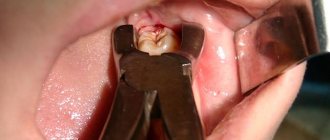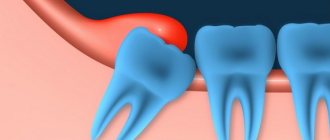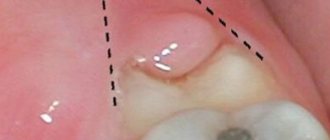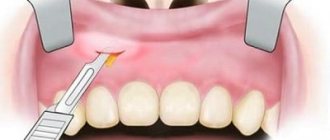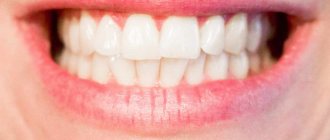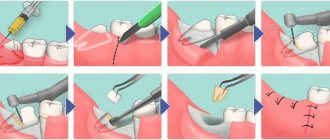31.10.2019
Today, dentists successfully treat almost any disease of the teeth and gums. Their arsenal includes advanced technologies and modern techniques that allow them to find a way out of the most difficult situations. But sometimes the only possible solution is removal - this is a drastic measure that is resorted to in desperate cases. The procedure is ordinary, and therefore complications after it occur quite rarely. It is important to contact an experienced surgeon and conscientiously follow all his recommendations in the postoperative period. Today we’ll talk about how tooth extraction in the upper jaw differs, what difficulties there may be and how the procedure is carried out.
Removal of upper teeth - what are the features?
The upper jaw has its own anatomical features. So, for example, implanting upper teeth is somewhat more difficult. The bone tissue is looser, which is why the implanted rods take several months longer to take root. Low jawbone density is due to less chewing load that falls on it. Therefore, after removal, it atrophies faster. But if implantation becomes more complicated, then with surgical extraction of teeth things are different - here the procedure is easier and simpler than on the lower jaw.
Choice of anesthesia - general or local
As noted above, the bone tissue here is less dense. It is covered by a thin membrane called the “cortical plate”. It contains a large number of openings for nerves and blood vessels. Due to this, there are no problems with the administration of local anesthesia. Removal of the upper teeth is usually easy and quick, without any discomfort. In this case, there is no need to consider general anesthesia as an alternative option for pain relief.
Risk of injury to the maxillary sinus
The maxillary sinus is located in the internal structures above the upper jaw. Often its shell is located in close proximity to the roots. If the extraction technology is violated, the sinus can be damaged, which will lead to its perforation or rupture. This complication is typical for the procedure for extracting chewing elements and wisdom teeth. It causes a number of symptoms indicating sinus injury. For example, when you eat or drink, ingested liquid and air may exit through the nose. Sometimes foam appears in the vacated hole, and during probing the instrument penetrates much deeper than it should.
This complication is a consequence of medical errors. To correct the situation, the injured membrane will have to be sutured. Sometimes perforation of the sinus leads to increased temperature, suppuration, and the development of sinusitis and sinusitis. In serious cases, the patient may be hospitalized, undergo a full-fledged operation and be prescribed a course of antibiotics.
Entry of part of the root into the sinus
Sometimes, when the maxillary sinus is damaged, part of the root penetrates into it. And this is again a medical error caused by incorrect advancement of the tooth at the time of its extraction. Often such a complication occurs against the background of thinning of the bone plate. Simply put, the tooth breaks and part of its root system “slips” into the sinus.
Among the characteristic symptoms, dental experts identify fluid and air entering the nose through the mouth, severe runny nose, high temperature, and pain in the nose. To clarify the diagnosis, the patient is sent for an X-ray examination. Next, he is prescribed a full-fledged operation, which is carried out in a hospital setting.
Wisdom teeth - difference from other teeth
This tooth is no different from other molars in its structure. If it erupts without pain, does not cause discomfort to the person and has normal roots, then they do not get rid of it. Its cutting is often accompanied by acute or dull pain, lack of comfort when eating food and other unpleasant symptoms. The upper teeth can cause food stuck and damage to the mucous membrane, and the lower teeth can lead to the formation of a purulent hood, caries, etc.
The main differences are two factors:
- excessively curved or fused roots;
- the same curved root canals.
The first factor is reflected in the difficulty of extraction: the roots grow together and can have the most bizarre shapes. This is what causes the main difficulties for painless elimination. The second factor provokes difficulties with further treatment: canals of this shape are very difficult to subject to filling and mechanical stress.
How painful is it to remove upper teeth?
Today dentistry has all the capabilities to treat any complexity without pain and discomfort for patients. Even complex removal of the posterior destroyed element, including the figure eight, can be carried out quickly and completely painlessly. When working on the upper jaw, local anesthesia is usually sufficient. If desired, the patient can insist on the use of general anesthesia, for example, if he has a panic fear of dental treatment. Here you need to understand that the use of such powerful anesthesia has a whole list of contraindications and requires serious preparation.
An excellent alternative can be sedation, which involves placing the patient in a semi-conscious state. Fear and anxiety disappear, the person feels completely calm and relaxed, and can respond to simple requests from the doctor. It is noteworthy that after the sedation ends, the patient may not remember how the procedure took place. It should be understood that sedation is only an addition to pain relief and does not exclude the use of local anesthetics.
How much does tooth extraction cost?
How much does tooth extraction cost?
Many patients ask the question: how much does tooth extraction cost and why do the prices for removal differ so much in different clinics? To answer this, we present you with a few defining points:
- diagnostics
- tools
- doctor's experience
- time allotted for the procedure
It is these nuances that determine not only the final cost of the operation, but also the positive result itself, which, if diagnosed correctly by an experienced doctor, is guaranteed.
Contraindications to the procedure
The extraction procedure (that’s what it’s officially called) has its limitations. It should be noted that almost all contraindications are relative, which means that after eliminating limiting factors, removal can be carried out. These phenomena and conditions include the following:
- acute infectious diseases,
- blood clotting disorders,
- first and last trimester of pregnancy,
- 2 days before and after menstruation,
- diabetes in an uncompensated stage,
- pathologies of the heart and blood vessels,
- mental illnesses in aggravation.
Sometimes emergency removal is required, and then there is simply no time left to eliminate the above-mentioned obstacles. In this case, the doctor takes on additional risk and performs the procedure as carefully as possible. It is better if it is a truly experienced and qualified dental surgeon.
What complications can wisdom teeth cause?
Difficulties arising from third molars are primarily associated with the late timing of their eruption and some anatomical features of the jaw structure:
- Lack of space for normal eruption. By the time the “eights” begin to cut, a person’s dentition is usually already fully formed, and there may simply not be enough space for the third molars. In addition, during evolution, the human jaw has decreased by about 1 cm, which also does not contribute to the normal growth of “eights”. In this case, tooth extraction is indicated to prevent displacement of the entire dentition.
- Incorrect position in a row (dystopia). Leads to soft tissue injuries, destruction and displacement of adjacent teeth.
- Incomplete eruption (retention). Impacted “eights” cause a lot of problems and discomfort - often such a wisdom tooth causes inflammation of the gums and diseases of the “neighbors” in the dentition.
- Pericoronitis. An inflammatory disease characterized by swelling of the gums near the wisdom tooth followed by suppuration. When teething is difficult, a so-called hood of mucous membrane is formed around the figure eight, which is the optimal place for the accumulation of food debris and the proliferation of bacteria. In this case, the wisdom tooth is cut and hurts due to inflammation of the hood. If nothing is done, gum inflammation develops not only next to the tooth, but throughout the entire jaw - this will require long-term and costly treatment of the gums.
- Deep caries of wisdom tooth. Third molars, as a rule, begin to deteriorate quickly, often at the eruption stage. Why do wisdom teeth crumble? This is due to both the peculiarities of its structure and its position: it is simply impossible to clean the “eights” well with paste and a brush, so food debris and bacteria necessarily accumulate there, creating favorable conditions for the development of infectious processes.
In all the described situations, it is better to remove wisdom teeth immediately, without waiting for serious complications to develop, and you will have to spend a lot of time and money on treating nearby teeth, as well as inflamed gums.
Description of the procedure: how it is carried out
If the patient is undergoing a planned operation, then first he is sent for an X-ray examination and tests. After studying the diagnostic results, the doctor begins the procedure or prescribes it for the next free time. Complex extraction is recommended to be carried out at the beginning of the day. It is better not to eat or drink immediately before visiting the doctor - this will help enhance the effect of the anesthetic. If the patient suddenly catches a cold before removal, it is better to reschedule the procedure.
First, the specialist administers anesthesia. If a simple operation is to be performed, its duration will be no more than 20 minutes. Using special forceps, the doctor carefully clamps the crown, rocks it with a special movement, and then sharply pulls it out of the socket. Lightly compresses the edges of the wound until the hole is completely filled with blood and a blood clot is formed - protection against infection and mechanical damage. Next, the doctor treats the injured tissue with an antiseptic, prescribes painkillers, and in some cases antibiotics, and gives detailed instructions about the postoperative period.
Complex extraction
The preparation stage here follows the same principle. A specialist is recommended to take an x-ray to determine root growth.
Is it painful to remove an upper wisdom tooth? After the anesthesia takes effect, the pain goes away and doctors begin surgery. It is carried out according to this scheme:
- the gum tissue is cut, after which it is peeled off from the bone;
- an area that is open (part or all of it) is cut out;
- The molar is removed, using an elevator or forceps;
- the hole is inspected to see if parts of the root remain;
- the wound is washed with antiseptic, anti-inflammatory solutions;
- the hole is stitched along the edges.
Difficult removal of a wisdom tooth (eight) - what are the features?
Complex removal usually concerns teeth with a branched root system, impacted, dystopic, destroyed elements, and figure eights. In this case, the procedure looks like this:
- the specialist makes an incision on the gum, peels off a flap of the mucous membrane,
- if the tooth is located under a layer of bone tissue, it is literally cut out using a special bur,
- then the element is carefully removed in parts, for which special forceps are used,
- the doctor cleans the hole and treats the tissue with an antiseptic,
- the resulting cavity is filled with osteo-replacing material and covered with a protective membrane to prevent the growth of the mucosa,
- the wound is tightly sutured.
The procedure can last 40-60 minutes. A few days later, the patient is invited to a second visit so that the specialist can assess how successful the healing process is.
Difficult removal
When removal is considered difficult:
- if there are impacted “eights” (unerupted wisdom teeth);
- dystopic “eights” (incorrectly positioned);
- multi-rooted molars;
- the root is severely bent or damaged;
- fusion of bone tissue with the tooth root;
- the presence of a cyst or fistula.
Typically, complex removals require more time.
What is the difference between a simple and complex removal procedure?
Simple deletion is considered in the following cases:
- movable tooth;
- single-rooted or double-rooted tooth;
- baby tooth.
The easiest way is to remove a mobile baby tooth. Sometimes it is performed without anesthesia and goes unnoticed by the patient.
As mentioned above, complex procedures most often include the removal of wisdom teeth. “Eights” quite often do not erupt completely or grow incorrectly. Therefore, many people, when a third molar appears, try to delay a visit to the dentist, dampen the discomfort with painkillers and postpone treatment “for later.”
It is best to immediately, when the “eight” appears, come for an examination to a dentist, who, having seen any deviations, will be able to immediately remove the tooth.
Possible complications
Complications are more typical for cases of complex removal. And even with the extraction of a wisdom tooth, if the operation is performed on the upper jaw, the risk of developing undesirable consequences remains minimal. A dangerous complication after removal is alveolitis - inflammation of the socket with possible suppuration. The mucous membrane in the area of the defect turns somewhat red, swelling appears, the blood clot disappears, and instead a yellowish coating with an unpleasant odor appears. There may be discharge of pus and increased body temperature.
Important! When answering the question about how long it takes for a wound to heal after removal, it should be noted that pain and swelling usually go away within 3-4 days. If during this time the pain only intensifies, consult a doctor immediately.
Another possible complication could be injury or perforation of the nasal sinus, or penetration of part of the root into it. Typically, this situation occurs due to the fault of the doctor if he pressed too hard on the instrument. To avoid such troubles, it is important to take the choice of a clinic and doctor seriously, as well as follow all the specialist’s recommendations after the procedure until the tissues are completely restored.
What does the sensation of pain depend on?
How painful it is to pull teeth, according to research, depends on several factors. In the same patient, the intensity of pain during extraction may vary depending on the following signs:
- a molar or baby tooth needs to be pulled out - removal of a baby molar is almost painless, since it does not have powerful long roots, like those of a permanent one;
- location on the jaw arch - frontal molars are removed with a feeling of much less intense pain, since they are smaller in size, their root system is not as developed as that of the lateral teeth. The same can be said about trauma to the surrounding soft tissues - they suffer less, especially in comparison with wisdom tooth extraction;
- tooth shape and number of roots - by nature, human molars can have 1-2 or 3-4 branches of a stabilizing root system. So, tooth extraction will be more uncomfortable the more root branches the molar has.
It is necessary to clarify that whether it is painful to pull out a tooth depends not only on the listed factors, but also on the perception of the procedure by the person himself. If you experience a feeling of panic and intense fear before the extraction, this psychological state can directly affect the procedure and actually provoke intense pain. There are many stories among patients not only about how much pain is felt during extraction, but also that there is a big difference whether a molar is removed from above or below, supposedly this affects the intensity of the discomfort.
We need to figure out whether these rumors have a scientific basis. Dentists claim that, regardless of the location of the tooth, it can be removed completely painlessly if high-quality anesthesia is administered, but the jaw may begin to hurt after the end of the freezing period. The severity of the pain syndrome will depend on several points:
- how much bone and soft tissue was destroyed;
- is there an acute inflammatory process at the time of removal;
- a frontal or lateral tooth is subjected to extraction;
- the lower or upper molar is removed;
- whether there is an accumulation of pus in the area of the unit being removed.
The fact that lower units are more difficult to remove from the bed is also due to the density of the bone tissue. All these factors directly affect the degree of destruction and recovery time after the molar has been removed. Therefore, it makes no sense to say that it is painful to remove the lower teeth, but not the upper ones; the location will only affect the adaptation period after extraction.
Is it possible to perform prosthetics immediately after root removal?
Single-stage implantation is a technology that allows you to restore a tooth immediately after its extraction. This technique makes it possible to significantly reduce treatment and restore the aesthetics and functionality of your smile in the shortest possible time. This concept includes immediate loading protocols, but in some cases a classic implant is fixed using standard two-stage technology.
However, today experts prefer one-stage methods. According to the results of numerous clinical studies, implantation using a one-stage technology immediately after tooth extraction protects bone tissue from atrophy and reduces treatment time with a guarantee of long-term results of up to 96%1.
“I needed to remove one decayed tooth, but the problem was that it was in sight. I wanted to do everything right, but I was very worried that I would have to walk around with a hole while the implant took root. And then I came to you, and they offered me a one-step implantation. The tooth was carefully removed and an implant with a crown was immediately placed in its place. The procedure went quickly, completely without pain, although I still had doubts about local anesthesia and thought about going under anesthesia. I am immensely grateful to your specialists!”
Lyubov Vyacheslavovna K., 46 years old, review on the website of a Moscow dental clinic
After extraction, restoration of bone tissue is not required - the implant is implanted into the vacated socket and can be additionally strengthened with bone replacement powder. In this case, a temporary crown is immediately fixed, and after a few months, when the implant has fused with the jawbone, it is replaced with a permanent single prosthesis. A temporary crown is created from a lightweight material – plastic. It turns out to be slightly shorter than the neighboring elements, which avoids intense mechanical impact and displacement of the artificial root.
Important! Single structures are fixed only in place of single-rooted front teeth (incisors and canines), which are not subject to intense exposure. Their main function is to restore the aesthetics of the row.
But this procedure is not possible in all cases. Implantation is a serious operation that cannot be performed without careful preparation. It is necessary to study the clinical picture, exclude possible contraindications, and select an implant model. Most patients turn to dentistry when emergency removal is required, and there is simply no time left for preparation.
Molar removal technology
Before proceeding with the removal of a molar, the doctor must make sure that there is no curvature of the roots. For this, an x-ray is taken. If the roots are not bent, the patient is given an anesthetic injection. After 10 minutes, the tooth can be removed.
First, the dentist carefully separates the gum from the body of the tooth. Then he grabs the tooth with pliers and begins to swing it and rotate it at the same time. After several such manipulations, the doctor pulls the tooth out of the alveoli.
In this sequence, both the upper and lower root teeth are removed. However, it is somewhat more difficult to grasp the upper molars with forceps.
Sometimes, when removing a molar, the doctor must first cut it into two or three parts and then pull out each part separately. This usually happens when the roots are bent.
In case of severe curvature of the roots, when they intertwine with the roots of neighboring teeth, removal must be done in fragments and under general anesthesia. In this case, the doctor completely exposes the gum around the diseased tooth.
If there is a cyst in the area of a diseased molar, the doctor is required to be highly qualified. This removal is done under both local and general anesthesia.
Two days after the removal of a molar, the patient must visit the dentist again to take an x-ray. This is necessary to ensure that all tooth roots have been removed.
Estimated cost of the procedure
According to the compulsory medical insurance policy, a tooth can be removed completely free of charge, in a state clinic. In private clinics, the procedure will cost from 1,500 to 3,000 rubles, depending on the degree of complexity. In some situations, the cost of the operation can even reach 15 thousand rubles or more, for example, with a complex extraction of the figure eight using sedation.
As for immediate recovery, the cost of such treatment using inexpensive brands will cost approximately 30-50 thousand rubles - this includes x-ray diagnostics, 3D planning and tests. Restoration with the installation of a more expensive Nobel Biocare implant and an adaptation crown will cost approximately 70-90 thousand rubles.
Category: Tooth extraction Published by Mister stomatolog



